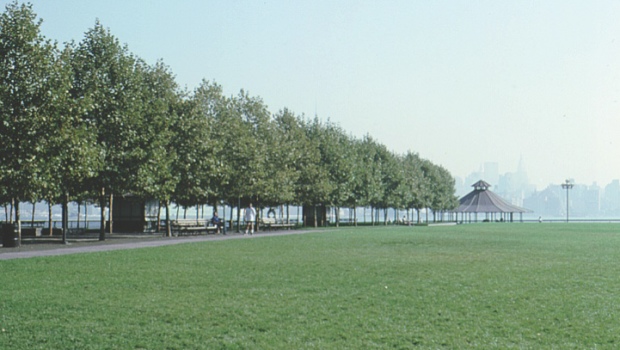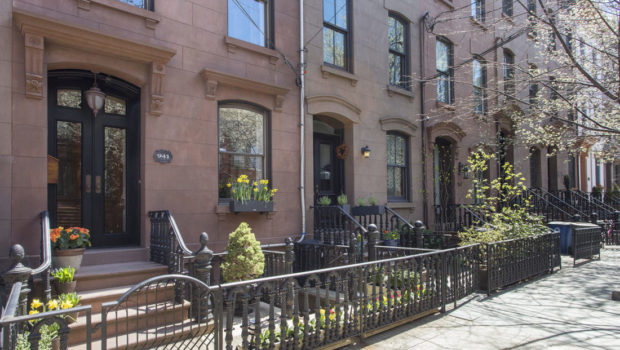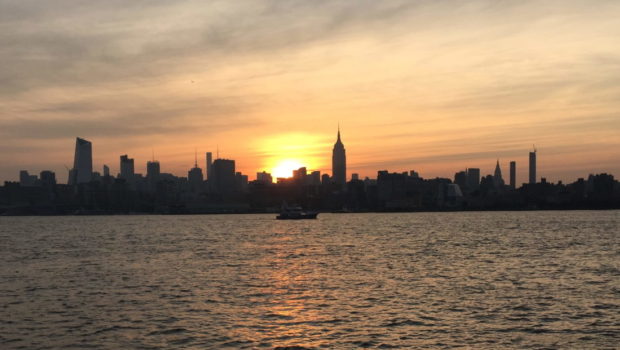
On the (Better) Waterfront
Story by: Jack Silbert
Photos by: Ron Hine and courtesy of Fund for a Better Waterfront
It’s a gorgeous summer morning, so you head over to Pier A. But when you get there, you find a 33-story office tower blotting out the sun. No, it’s not a lost episode of The Twilight Zone. This would’ve been reality, according to the city’s development plan for the south waterfront in the late 1980s. Thankfully, a volunteer group that would become the Fund for a Better Waterfront prevented it from happening—and then began fighting for a continuous public park along the Hudson River in Hoboken. Their tireless work continues to this day, ready to do battle any time the specter of overdevelopment appears.
Helping lead the charge is executive director Ron Hine. The Urbana, Illinois native arrived in Hoboken back in 1969 after attending graduate school at the University of Pittsburgh. As a community service activist, Hine dealt with issues such as tenant organizing and welfare rights — but didn’t give much thought to the river’s edge. “It was still a working waterfront,” said Hine, “even though those activities were gradually fading away.” The waterfront was difficult for the average person to access, and giant “head house” buildings (where goods unloaded from ships could be stored) sat by the water from 1st to 4th Street — on land leased by the Port Authority.
By the late 1980s, nearly all vestiges of the shipping industry were long gone from the city’s waterfront. The nature of the business had changed, switching from crates, nets, and grappling hooks to the giant steel containers that are easily transferred from ship to train to truck — a style of shipping that Hoboken’s piers couldn’t handle. In 1988, the state of New Jersey began mandating that developers leave a minimum of 30 feet of public space along the waterfront. But development simply hadn’t happened on Hoboken’s waterfront. (Blame politics and logistics.) It was as if development projects came there to die.
And then one day, Hine received a call from a local group known as Save Hoboken from Over-Development. He says, “When the city of Hoboken signed an agreement with the Port Authority to develop the south waterfront, they wanted to try to stop it.” The city’s plan called for 3.2 million square feet of development between 1st and 4th Streets, including the massive office complex on Pier A and residential housing on Pier C.
Hine was a natural choice to join the fight, having helped prevent projects such as a 30-story tower on lower Adams Street and a series of high-rises along Observer Highway. So in 1989, a new group formed, called the Coalition for a Better Waterfront. A city referendum on the development question was scheduled for July 10, 1990, so the Coalition tried to get the word out. “We ran very much a grassroots campaign,” Hine recalls. “We didn’t have money.” Their main arguments: The project was entirely too big for the city, and it would wall off most residents from the waterfront. The pro-development advocates were persuasive too: Elected officials said that voting for the project would mean lower taxes.
“We had no political support, absolutely none,” Hine says. On the referendum date, voter turnout was surprisingly high. Results were very close, but the development project had been defeated. “The politicians were totally stunned that we won,” Hine remembers. The city put the issue back on the ballot in 1992, hoping to undo the previous results, and poured vast amounts into advertising. But Hine and his colleagues had some new ammunition as well. “By then we had our plan,” he says.
Just after the 1990 referendum, the Coalition had morphed into the non-profit Fund for a Better Waterfront (FBW). “We felt very strongly that we had to come up with a positive vision for what could happen,” Hine recalls. “We didn’t just want to be against whatever the city proposed.”
FBW quickly hired noted architect and urban planner Craig Whitaker to develop a proposal for Hoboken’s waterfront. During a walking tour with Whitaker, Hine’s confidence wavered somewhat. “It was just this derelict waterfront,” he remembers. “I was totally overwhelmed, thinking, ‘Oh my God, how are you ever going to fix this mess?’” But Whitaker was unfazed. “As soon as I told Ron and his cohorts that Hoboken had the only opportunity— of any city from Bayonne to the George Washington Bridge—for a continuous public waterfront, that became our rallying cry,” he recalls. “A public park from one end of town to the other.”
Whitaker had studied successful waterfronts around the globe, and had a straightforward philosophy. “The secret to getting a public park was to separate it from development by a street,” he explains. In Hoboken’s case, that street would be Sinatra Drive: with businesses on one side of the street (their front doors facing the water), and the park on the other side. To help residents visualize this plan, Whitaker suggested constructing a scale model. There was one small problem. “FBW didn’t have 15 cents to hire a professional model maker,” Whitaker says. Undaunted, they set out basswood, box cutters, and Elmer’s glue, and invited everyone in town to pitch in. “We told citizens they could build their own block,” he remembers. (Volunteer architects, meanwhile, handled the more complicated buildings.)
Armed with Whitaker’s plan and model, and with slight shifts in the city’s political landscape, the FBW was victorious again in the 1992 vote, by an even wider margin. In 1995, the city adopted most of the FBW’s waterfront plan. Sinatra Park was completed in 1998, with Pier A Park arriving the following year. The Port Authority paid for the construction of Pier A Park, and also for new streets, installation of pipes, and other infrastructure. Per the agreement, the Port Authority is being paid back over time by the development on the west side of Sinatra Drive between 1st and 4th Street. This development also pays into a maintenance fund for upkeep of the park. Hoboken’s public waterfront was well underway, yet FBW’s job was far from over.
“You’d think you create a plan for the whole waterfront and that’d be the end of it,” says Hine. “But it didn’t work that way. So we have all of these individual battles.” In 2000, for example, developers unveiled sprawling plans for the site of the former Maxwell House plant uptown (which had closed in 1992)—including townhouses on the piers. That didn’t jive with a continuous waterfront park, and Hine let them know.
Discussions began, with the FBW bringing in Whitaker and other specialists. They presented a new plan for the site. “We were saying, you’re basically getting the same number of residential units, but you’re also getting the waterfront park,” Hine states. “Simple deal, really.”
When the Maxwell Place Park opened in 2007, it was clear that developers had cut some corners from FBW’s proposal. But with five more acres of public park along Hoboken’s waterfront, it was still a major victory.
Developers aren’t the only threat to the river’s edge — there is also nature. “Remarkably, much of the waterfront held up very well during Sandy,” reports Hine. “Out of the 200 trees at the south waterfront, we lost maybe two.” He credits careful park design, the park’s proper elevation, and innovative planting techniques.
As the city enacts a comprehensive flood plan, FBW intends to assist with public awareness. With a mix of dedicated volunteers and hired experts when needed, the FBW has been a dependable presence whenever development questions arise. Registered as a 501(c) (3) non-profit organization, FBW is required to have a Board of Directors (including its spirited president Jim Vance; Nick Borg, who Hine worked with in his earliest Hoboken community-service days; and Augusta Przygoda, an original member of the Coalition for a Better Waterfront). FBW does receive foundation support — which ebbs and flows with the economy— but most funding comes from individual contributions.
These days, FBW keeps an eye on several waterfront issues, including the Stevens Institute parking lot and maintenance building (which FBW suggests moving to the other side of Sinatra Drive); FBW’s recommendation to expand the Little League field and extend 4th and 5th Streets to the waterfront; the eventual sale of the Union Dry Dock property at 9th Street (the last remnant of the working waterfront); and the controversial Rockefeller Group property uptown.
Then there’s the Monarch Project. The Shipyard Associates had agreed to create open space on the 15th Street pier, but now intend to erect two 11-story towers instead. The FBW claims this is illegal according to state regulations and new flood ordinances. “The Monarch Towers violate a basic principle for us,” Hine says. “They want to build on the wrong side of Sinatra Drive, out on the pier.” With much of Hoboken’s water front park completed, and finishing the job well within grasp, the FBW vows to keep fighting for the public’s interest. Achievements such as the south waterfront keep Ron Hine motivated. “I walk there and nobody knows who I am, but still, I feel good,” he says. “I’ve been involved in a lot of things where you look back and think, ‘Well, what did I accomplish?’ But here, it’s a physical manifestation of all the good work we did. And that’s very gratifying.” ••

 Previous Article
Previous Article Next Article
Next Article BILL’S SPACE SHOW: Episode 2 | The Rob Nicholas Band Performing “Rise” (LIVE – 1 Night in Hoboken)
BILL’S SPACE SHOW: Episode 2 | The Rob Nicholas Band Performing “Rise” (LIVE – 1 Night in Hoboken)  hOMES: Weekly Insight Into Hoboken & Jersey City Real Estate Trends | January 8, 2021
hOMES: Weekly Insight Into Hoboken & Jersey City Real Estate Trends | January 8, 2021  FEATURED PROPERTY: 937 Summit Ave, Jersey City — 3BR/1.5BA | Single-Family Home | $525,000
FEATURED PROPERTY: 937 Summit Ave, Jersey City — 3BR/1.5BA | Single-Family Home | $525,000  hOMES: Weekly Insight Into Hoboken & Jersey City Real Estate Trends | January 5, 2018
hOMES: Weekly Insight Into Hoboken & Jersey City Real Estate Trends | January 5, 2018  FEATURED PROPERTY: 941 Bloomfield Street | Uptown Hoboken Brownstone | 4BR/2.5BA — $1,900,000
FEATURED PROPERTY: 941 Bloomfield Street | Uptown Hoboken Brownstone | 4BR/2.5BA — $1,900,000  hOMES: Weekly Insight Into Hoboken & Jersey City Real Estate Trends | September 21, 2018
hOMES: Weekly Insight Into Hoboken & Jersey City Real Estate Trends | September 21, 2018  hOMES: Weekly Insight Into Hoboken & Jersey City Real Estate Trends | November 16, 2018
hOMES: Weekly Insight Into Hoboken & Jersey City Real Estate Trends | November 16, 2018  hOMES: Weekly Insight Into Hoboken & Jersey City Real Estate Trends | April 5, 2019
hOMES: Weekly Insight Into Hoboken & Jersey City Real Estate Trends | April 5, 2019